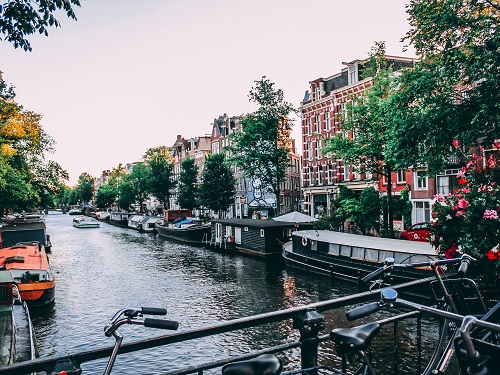
The Amsterdam Institute for Advanced Metropolitan Solutions (AMS) has announced that it is testing the world’s first fleet of driverless, battery-powered, autonomous boats on Amsterdam’s Waterways.
‘Roboat’
The tests involve battery-powered, autonomous boat prototypes, dubbed ‘Roboats.’ These prototypes are the result of three years of research, building up from 1:4 and 1:2 scale prototypes to the full-size versions. The research is part of a joint program between AMS and Massachusetts Institute of Technology.
Floating Dumpsters
One of the first full-size prototypes is a floating dumpster which could, if introduced full-time, play a key role in clearing Amsterdam’s canals from waste and improving the city’s waste separation rates. This is because the inconvenience of the current process of having to take different types of waste to distinct locations has discouraged residents from separating waste correctly, but a dumpster coming to them could help turn things around. Using a fleet of autonomous dumpster ‘Roboats’ could also speed up waste collection not just in Amsterdam, but in other water-based cities, where there is a real need for both infrastructural improvements and a nimble waste collection system.
Taxis Too
With Amsterdam’s 60 miles of canals stretching across the city, another anticipated use that is being tested with ‘Roboats’ is water taxis that could help to achieve the concept of “smart urban mobility”. These taxis could prove to be a much more environmentally friendly (no emissions like combustion engines), and enjoyable way to get around the city, particularly for tourists.
Canals Being Used As Goods And Passenger Transportation Routes Again
Udo Kock, the former Deputy Mayor of the City of Amsterdam sees a commercial version of the Roboats (in ten years’ time) creating a situation where “Amsterdam’s canals could again be used intensively for goods transport. Just like three centuries ago.”
How They Work
The autonomous boats use Laser Image Detection and Ranging (LiDAR) data for localisation and mapping so that the on-board computer can constantly compensate for external factors that influence the boat’s direction (wind, current and waves) and sail along a specific route while avoiding obstacles.
Roboats also use ‘automatic docking’ whereby they can autonomously steer and latch themselves to appropriate docking stations using two opposed-pairs of robotic arms which can be deployed to securely grab onto the stationary poles of a dock or the sides of another Roboat.
What Does This Mean For Your Organisation?
For many organisations, and for the city itself, an existing extensive network of canals coupled with a 24/7, all-year round, efficient (autonomous) transportation service could represent a real opportunity for goods and passenger transportation.
Also, the busy port of Amsterdam where there are lots of vessels, quays and piers is a great place to test and improve the safety with autonomous systems to ensure that the commercial product, when it is ready in several years’ time, is highly effective, safe, and provides maximum value for organisations that use them.
The fact that Roboats are lithium battery-powered and, therefore, don’t emit greenhouse gasses like petrol-powered road vehicles makes them an ideal, sustainable, environmentally friendly urban transportation method for the city’s future.




